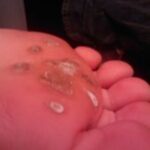Frogs and toads have a tough enough go of things as it is and should not be blamed for causing warts just because they have bumps on their skin. In truth, warts are brought about by the human papillomavirus, of which there are at least sixty-three different kinds; you cannot get warts from touching or handling frogs and toads, no matter what your grandfather may have told you. Warts are in reality a non-cancerous skin growth in the top layer of the skin. Most warts go away on their own as time passes, but there are many treatments available to speed up the process of removing warts.
Wart viruses can be passed from person to person and through contact with an object that has been used or touched by someone with warts. The human papillomavirus responsible for warts enters the skin, often where a recent or current injury is, and precipitates a rapid growth of cells on the outer layer of the skin. Warts can appear on various parts of the body, depending on the type of virus you have made contact with. Every individual’s immune system handles warts differently, so not everyone who encounters the warts virus will develop them. There are kinds of warts, such as genital warts, that are very contagious, but the three most widespread types of warts are all non-genital. Once you have the warts virus in your skin, it can take as little as one month or as long as eight month for the wart to appear.
The three most frequent types of warts found on people are common, plantar, and flat warts. Common warts usually will show up on the hands, in the region around the fingernails. They are grayish in color and raised from the surface of the skin, covered with rough bumps. Plantar warts occur on the bottom of one’s feet in such high pressure areas as the heel and just behind the toes. Flesh colored or light brown, plantar warts are also called seed warts because they can have a small black dot in them, clotted blood vessels that resemble a seed. These warts grow into the skin, not outwards like common warts do, making them among the most difficult warts to deal with. Flat warts arise on the face and back of the hands the majority of the time, as small bumps about a quarter of an inch in diameter. Flat warts are smoother than other warts and are found most often in children and teenagers. Genital warts are often symptoms of a sexually transmitted disease and can grow on your genitals, pubic area, inside a woman’s vagina, and in the anal canal.
The location and appearance of a wart will help your doctor decide what kind it is. If your physician cannot tell, they may use a scalpel to scrape a bit of it off and send it out to a laboratory to make sure it is not, in reality, skin cancer instead of a wart. Sometimes doctors will do what is called a punch biopsy on a wart, removing a deeper sample for inspection at the lab. Warts pose no threat to your health in most cases, but for cosmetic reasons people like to see them gone. No matter what remedies you try, warts will vanish almost three-quarters of the time, a fact which gave rise to a number of strange home remedies. One such remedy involved rubbing a potato cut in half on the wart and burying the other half of the potato in your back yard!
Home care for warts has one goal in mind, to force your body to realize that the wart is a foreign invader and get it to destroy it. One such treatment employs the use of duct tape or several layers of waterproof adhesive tape placed over the wart for six and one half days. At the end of that time frame, remove the tape, but only for twelve hours. Soak the wart in water for a few minutes and then rub it with a pumice stone or an emery board. Put the tape back for another six and a half days and repeat the treatment. The airtight and moist conditions under the tape do not allow the virus to grow, and this method works best on warts that are around the fingernails. If the tape treatment fails to help get rid of the wart, discontinue it after a couple of months. Salicylic acid is the main ingredient in wart medications such as Compound W, and can treat warts on the hands, feet, or knees. Apply the acid everyday for weeks, usually after a bath or shower, as it sinks in further when your skin is damp. Take the pumice stone or emery board the next day and go to work on the wart before your bath or shower. Be sure to apply salicylic acid only to warts, as it can damage normal skin. Neither of these two treatments should be tried on genital warts.
More aggressive treatment for warts can be done in your doctor’s office. Liquid nitrogen can be used to deep freeze the tissue in a wart, forcing the human papillomavirus out where the body’s immune system can destroy it. This treatment must be applied every one to three weeks for a total of up to four times before the wart is gone. Laser therapy can vaporize wart tissue, and surgery can remove a wart when everything else fails. Genital warts can be removed with the liquid nitrogen method, and there are other chemical treatments; some can be applied at home and others must be done by a doctor. Other methods of removing genital warts include laser therapy, injections of interferon which can boost your immune system in its battle against the virus causing the warts, and loop electrosurgical excision, where a sharp instrument shaped like a noose cuts the warts out of the skin. Warts can come back even after they have been removed, especially in the case of genital warts. To help to prevent warts, avoid brushing, shaving, or combing over areas where they are so as to not spread the virus. Don’t walk barefoot in public areas like pools and locker rooms, refrain from using the same nail file or clippers on your warts that you use on your nails, and if you have warts, you do not want to bite your fingernails.




